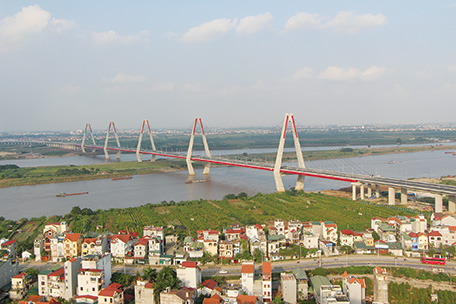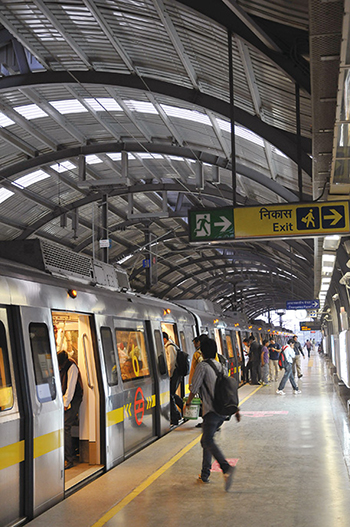ODA Topics 01
Quality Infrastructure Investment
Lack of infrastructure impedes economic growth and the improvement of people’s livelihoods all over the world. There is a particularly severe lack of infrastructure in Asia. However, it is important to understand that infrastructure development in and of itself is not the goal. Rather, we must develop adequate infrastructure in a way that empowers Asia, so that it can continue to be the world’s growth center and drive the global economy. Furthermore, this growth must benefit all parts of the region and all members of society, including the socially vulnerable. There is growing awareness around the world that we need quality infrastructure investment to realize these goals. Quality infrastructure is included in the 2030 Agenda for Sustainable Development adopted in September 2015, and in the Leaders’ Declarations adopted in recent G7, G20, and APEC Summit meetings.
What does quality infrastructure investment entail?
It is obviously important that infrastructure should be easy to use, safe, disaster-resilient, and high-quality. However, on top of that, infrastructure development plans must not conflict with national and regional strategies for development and growth. Infrastructure should connect people, towns, regions and countries, and help unleash their potential for growth. It is important for infrastructure to be in harmony with the local environment, community, and people’s livelihoods. We must also consider future construction and maintenance work to ensure that infrastructure is cost-effective. In addition, infrastructure should generate local employment and facilitate technology transfer. Furthermore, it is essential to make careful adjustments and hold thorough discussions from a long-term perspective, and ensure compliance with relevant international standards and rules. This must be carried out from the planning stage. It is also necessary to utilize private-sector funding and know-how. Quality infrastructure investment takes all of these factors into account.
Japan has promoted quality infrastructure investment primarily in Asia for many years, and contributed to the development of this region. Asia’s current remarkable growth and prosperity are a clear indication that Japan’s approach to infrastructure investment has been correct.
For instance, Japan’s ODA was used to build the Delhi Metro, an underground mass transportation system in Delhi, the capital of India. This system has been in operation for more than 10 years now. Japan and India worked in close coordination to advance this project. The objective of the project was to solve some of the issues that arose from India’s growth strategy, including traffic congestions triggered by the growing population and private vehicles in the capital, and the economic losses caused by such congestions. Now, approximately 2.5 million people use the Delhi Metro on average each day. As a result, there are 120,000 fewer vehicles in the city, and traffic congestions have been significantly mitigated. Thorough and respectful dialogue was held with local residents and the community in the construction process. Detailed consideration was also given to the environment surrounding the construction sites. The project also succeeded in transferring Japan’s working standards and worksite culture for securing safe operations, maintaining train cars, adhering to delivery deadlines and ensuring safety. Additionally, the brake system incorporated a state-of-the-art Japanese energy conservation technology, helping the Delhi Metro earn revenue through CO2 emission credits. This is a good example of quality infrastructure investment.

The Nhat Tan Bridge in Viet Nam opened for traffic in 2015.
Similarly, Japan’s ODA was used to construct and open the Nhat Tan Bridge in Viet Nam in 2015. The opening of the bridge significantly reduced the time needed to travel between the Vietnamese capital of Hanoi and its airport, which is the main access point to the city. This in turn made logistics more efficient, and boosted the economic development and international competitiveness of the northern part of Viet Nam, where Hanoi is located. Overall, the project contributed greatly to Viet Nam’s growth and development strategy. Modern construction technology helped to significantly reduce the impact of construction work on the environment and improve its cost-effectiveness. Furthermore, the project generated local employment and transferred Japanese construction and quality control technologies to Viet Nam.
Japan will continue to lead Asia’s efforts to conduct quality infrastructure investment. Japan has pursued quality as well as quantity and will continue to do so in the future. To this end, Prime Minister Abe announced the Partnership for Quality Infrastructure in May 2015, which aims to promote quality infrastructure investment in Asia, in collaboration with various countries and international organizations.
One aspect of this Partnership is the expansion of quantity as well as quality. The Government of Japan will provide approximately $110 billion for quality infrastructure investment in Asia over the next five years, in collaboration with the Asian Development Bank (ADB). This is equivalent to an approximately 30% increase in the quantity of assistance. Furthermore, Japanese assistance and ADB funding will play a catalytic role in further mobilizing financial resources from private companies across the globe to Asia. To this end, the Government will expand and accelerate assistance through the full utilization of Japan’s various organizations and aid tools. At the same time, it will enhance the function of the Japan Bank for International Cooperation (JBIC) and strengthen collaboration with ADB.

Delhi Metro. (Photo: Osamu Funao / JICA)
Prime Minister Abe announced the Follow-up Measures of Partnership for Quality Infrastructure in November 2015. One of these measures is to carry out the improvement of Japan’s ODA Loans and Private-Sector Investment Finance, through the acceleration of procedures for Japan’s ODA Loans and establishing new schemes in Japan’s ODA Loans. Other measures include greater collaboration with ADB and structural reforms to JBIC.
The Government of Japan will utilize various fora to reaffirm with countries in Asia and around the world as well as with international organizations the necessity of promoting quality infrastructure investment to solve various development-related issues, such as the economic growth, poverty, and disparity of the world.
The Partnership for Quality Infrastructure is expected to facilitate a global flow of funding and know-how from various actors, including the private sector, to infrastructure development in Asia, which is an area full of potential. The Partnership will thus help create harmony between the environment and communities, and lead to powerful growth that leaves no one behind. In this sense, the Partnership for Quality Infrastructure is truly an investment for Asia’s future.
A case study on Quality Infrastructure Investment
Delhi Mass Rapid Transport System Project (India, Japan’s ODA Loan)
• Provides comfortable and convenient means of transportation for about 2.5 million people every day.
• Mitigates traffic congestion and air pollution in the metropolitan area.
• Disseminates the idea of safety first and the importance of on-time delivery at construction sites.
• Contributes to reducing electricity consumption and CO2 emission with a Japanese high-tech brake system.
